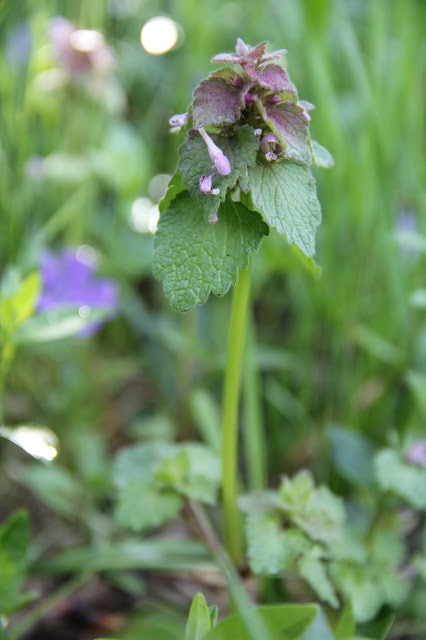Wildflowers of 2016 - #38 Small-flowered Forget-me-not (Myosotis stricta)
On Monday (09 May), I found one new species in the lawn at Chipp-A-Waters Park. Small-flowered Forget-me-not (Myosotis stricta) is a naturalized species found across North America. This species is also known as Strict Forget-me-not.
 |
| Small-flowered Forget-me-not plants often form large colonies in disturbed areas such as lawns |
This one of seven Myosotis species recorded in Michigan. All seven species have flowers with five petals. Six of the seven species have blue flowers - M. discolor flowers are yellow when they open but become blue. M. verna has white flowers.
 |
| Small-flowered Forget-me-not plants are small (2 to 8 inches tall) |
Small-flowered Forget-me-not plants are small, between 2 and 8 inches tall. Their flowers measure less than 1/8 inch across.
 |
| The name says it all - Small-flowered Forget-me-not (1/8 inch across) |
Wildflowers of 2016 - #39 Common Periwinkle (Vinca minor)
On Wednesday (11 May) I found an additional three species. My first flower of the day was Common Periwinkle (Vinca minor). This attractive native of Europe is considered an invasive species in some states. It forms large mats that can out-compete native plants and result in a monoculture covering large areas. Because of this growth tendency, Common Periwinkle is often grown as a groundcover in areas where grass will not grow.
 |
| Common Periwinkle - note glossy, evergreen leaves |
Common Periwinkle is found in every state east of the Mississippi River and 39 states in all. This species is probably under-represented in herbaria in Michigan - Michigan Flora does not show this species for Isabella County.
 |
| Common Periwinkle - note star-shaped throat of flower |
Also known as Myrtle, Common Periwinkle flowers are up to 1 inch across. Flowers are lavvender to light blue-violet petals and consist of a single shallow tubular part and five lobes that splay outward into a flat face. The throat where the lobes come together is shaped like a star. The leaves of Common Periwinkle are egg-shaped (ovate), glossy green in color, and are evergreen. This evergreen tendency is one of the things that gives this plant an advantage in competition over many native species.
Wildflowers of 2016 - #40 Purple Dead-nettle (Lamium purpureum)
My second wildflower of the day was a non-native member of the Mint (Lamiaceae) Family. Purple Dead-nettle (Lamium purpereum) is a common weed of lawns, fields, gardens, roadsides, and other disturbed habitats. It has been documented in all but eight states. In Michigan, it is common in the southern half of the Lower Peninsula; it has only been documented in three northern counties.
 |
| Purple Dead-nettle (Lamium purpureum) |
Wildflowers of 2016 - #41 Storks-bill (Erodium cicutarium)
My final species of the day was Storksbill (Erodium cicutarium). In 2014, this was species #227 and I didn't record it until September 8th. It flowers all during the growing season. I just never found a patch until then.
Storksbill is a common weed found throughout the United States and the lower half of Canada. This species is native to Europe, but has naturalized across many areas of the world.
 |
| Storksbill commonly grows in lawns across the United States |
This species is in the Geranium Family (Geraniaceae). While Michigan's other representatives from this family have leaves that have palmate lobes (meaning the lobes radiate from a central point like the fingers of a hand), the leaves of Storksbill pinnately compound (fern-like).
 |
| Storksbill - note five-petaled flower |
The flowers of Storksbill are small, measuring 3/8 to 1/2 inch across. The flowers have five petals and may be colored purple, pink, or white. After the pollination, the ovary of each flower elongates until it resembles the long bill of a bird - other members of the Geranium Family are known as Cranesbills.
 |
| Storksbill - note pinnately compound leaves and elongated seed pod |
No comments:
Post a Comment